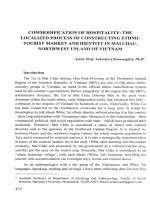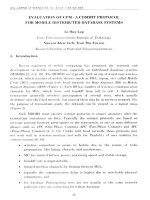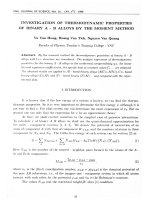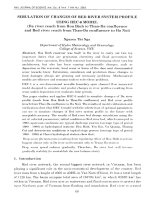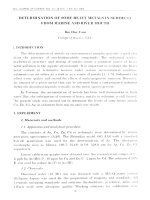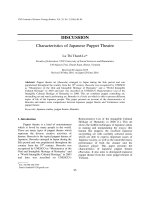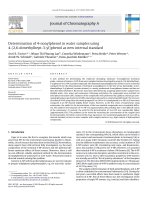DSpace at VNU: B-Regularity of Hartogs Domains
Bạn đang xem bản rút gọn của tài liệu. Xem và tải ngay bản đầy đủ của tài liệu tại đây (2.6 MB, 7 trang )
V N U . J O U R N A L OF S C IE N C E , M a t h e m a tic s - Physics.
T.xx,
N q 3 - 2004
B -R E G U L A R IT Y OF H A R T O G S D O M A IN S
N guyen T hac D ung
D ep a rtm en t o f M athematics, College o f Sciences, V N U
A b s t r a c t . Let Í2 be a bounded set ill c n and (ý? : ÍÌ —> [~oo, oo) an upper semicontinuous function oil Ỉ2. Consider the Hart-Ogs domain
= {(z, w) G i i x C : log \w\ +ip(z) <
()}. Ill this note, we give some necessary and sufficient, conditions oil B-regularity ƠÍ
1. I n t r o d u c t i o n
Let ÍÌ he a b ou n ded domain in R n . An im p ortan t question of (real) potential theory
is to ask whether every continuous function on ÔÍ 2 is th e b o u n d ary values of some harmonic
function oil ỈỈ. Using P e rro n ’s method, it can be shown t h a t the answer to this question
is affirmative if and only if at every point z of ÔÍỈ, we can find a subharm onic function u
ill ÍÌ such that lini£_>~ u(€) = 0 and limz->yu(€) < 0 , 7/ 7^ 2 on ÍÌ \ {z}. It is not hard to
S(‘(' that this characterization holds for every sm o o th ly b o u n d e d d om a in in R n (see [1]).
Now. it is n a tu ra l to ask a similar problem in the complex setting. Namely, if ÍÌ is
a bounded domain ill c \ under what conditions every continuous function / on di i can
!)(' (‘Xt('ii(l('(l t o a p l u r i s u b h a n n o i l i c : f u n c t i o n ill ÍỈ a n d c o n t i n u o u s o n Í Ì.
Tilt' Perron's m eth o d breaks down as the envelope
U'fii = sup{u(*) : u G P S H ( Q ) M m u l a n ^ ./}•
may not 1)0 upper semicontinuous.
To solve this problem, Sibony ill [3] introduced the following classes: B-regular
compact sot and B-regular domain. Roughly speaking, on a B-regular com pact set every
continuous function is the uniform limit of continuous plurisubharmoiiie functions oil opon
neighbourhoods of the com pact set. and B-regular dom ains a r e jlo m a in s such th a t every
continuous function oil ỠĨÌ can be extended continuously to
to a plunsiibharnionic
function ill ÍÌ. Under very mild conditions, Sibony showed t h a t Í2 is B-regular if di i is B
- regular.
The aim of this p ap er is to apply Sibony’s results to stu d y D - regularity of a
concrete class of dom ain. Namely, the class of H artogs dom ains. Let us defined what
wc mean by Ha.rt.ogs domains. Let ÍÌ be a bounded dom ain in c n and KỌ a real valued,
bounded from below, up p er semicontinuous function oil Q. Wc set
ÍĨ* =
■log 1^1 + v ( z ) < °}*
It is clear that the unit ball and polydisks in c n+1 are H artogs dom ains. However, we will
S(V later th at the unit polydisk is not B-regular (the b o u n d ary contains analytic structure)
Typeset by *4vt^’T^]X
1
2
N g u y e n Thac Dung
while I hr unit ball is B-regular (being a strictly pseucloconvex dom ain). Thus, the-' problem
())f characterizing the B-regularity of Hartogs dom ains is of interest. Ill this paper. we give
S401IK' necessary and sufficient conditions to ensure th a t. T h e present p ap er consists of two
pnuts. Ill the first section, we give some definitions and facts a b o u t B-I(‘gular compact
S i ( ' t s and B-regular domains. In the second section, we prove th e following theorem which
iiS tlio main result of the paper
T h e o r e m 1 . Lot ÍÌ and
as above. A ssu m e that ÍÌ - is B-regulnr. Thr u, wc hcivr:
i. Ọ € P S H { t t ) n C { t t ) .
ii. ÍÌ is B-regular.
Hi. ihnip(z) — + 0 0 ,
V( G Oil. Conversely i f n and if sa tisfy (i), (ii) rind (Hi) mid if
the set
X — {z G
is not strictly plurỉsubliãrm onic Ht z}
is locally B-regular then iip is B-regular.
W(' note that the condition on X can't remove. Indeed, if it is. we have i\ eount (Wxamplr (see example 3.2).
2. P r e l i m i n a r i e s
We first give some facts about B-regular com pact sets.
D e f in itio n 2.1 Let K be a compact subset of C " . We say th a t u is a phỉLV'i.subi1(1111 lovir
function oil A. denote by u E P S H ( K ) if the following two conditions ar<‘ satisfied
i. u e C ( K ) .
ii. There exist a sequence of open neighbourhoods {U j } Ji.! of K and a sequcner
{uJ } r*Ll such th a t Uj € P S H ( U j ) and u is uniformly appro xim ated by {Uj} oil
K.
D e fin itio n 2.2. Let K be a compact set in C " . A m easure // oil I\ is called <\ .Jensen
nic.dsuiv. with baiycenter at 2 £ K if// is Borrl positive, regular liH'asmr support ('(1 oil A
aid satisfies
w denote by ,/- the set of Jensen measures with barycentnr at z.
D efin itio n 2.3.
a) L('t K be c\ compact subset of C ". K is said to be D- regular if and only if for
('very continuous function u on K is uniform appro xim ated oil K by continuous
plurisiibharmonic functions on neighbourhoods of K .
b) A locally closed set X ill cn is said to be locally D - regular iff for every z £ X
there is a closed neighbourhood Vz such th a t X n v z is B - regular.
The following result, which is ail easy consequence of a d uality t h o o m n duo to
Elwards, gives us a connection between Jensen m easure and th e D regularity.
B-regularity o f H a rto g s d o m a in s
3
T h e o r e m 2.1. Let K 1)C a comjmct iu C " . Then K
for rill ; € A . wh('V('-ổ= is the D im e Iiicnsim' at z.
is D regnỈHỉ' if mid only if J z - {ổz }
w (' givr SOUK’ exam ples of B-regular com pact sets.
E x a m p l e 2 . 1 . If K is the unit c ircle then for every u G C ( K ). there is /7 continuous on
{ |:|
1 }. harmonic in {|/?| < 1}. such th a t u — LI oil K.
For ('rich t > 1. we let
ủ t {z) = ủ ( j ) .
Clrnrly. Ilf is harmonic ill {\z\ < t} an d ũị =t u as / tends to 1 . So. th(' unit circle is
B-n'^ular co m p a c t.
E x a m p l e 2 . 2 . If com pact set K is B-regular in C" then every compact subset K ’ of K is
B-I(^ular. Iiul('('cl. lot u e C ( /v ') . By the T ietze extension theorem, we call find ủ G C ( /\ )
such tha! f/ = u on K ' . Because' of B-regularity of K.
there-' arc' open neighbourhoods {Uj}
of I\ Mild Si'quonce {ũj e P S H ( U j ) } whose limits is equal to Ũ. Hence iij approximate* u.
Now. W(' giv(' SOUK' properties of B-n'gular compact sots brUS(‘(l oil [3].
P r o p o s i t i o n 2.2.
cl) I\ is B — regular i f and only if —\z\2 G P S H ( K ) .
h) UjJij/v,, is B-regular i f K n is B-ieguhir for each n.
Wo m a l l some definitions.
D e f in itio n 2.4. A bo un ded dom ain ÍÌ (£ C" is said to he D-Tc.cjidciv it toi t'vciy f11lie 11(>11
I' G C( di l ). there exists a function 11 G P S H ( Í Ì ) n C ( ỉ ì ) such th a t u
./•
D e f in itio n 2.5.
c\) A dom ain ÍÌ ill C" is said to be pscudoconvcx if there exists a plurisubhannonk
('xliaustion function u oil ÍÌ. i.i1 { 2 : u{z) < c} is relatively compact ill ÍÌ foi rill real
r.
h) A domain ÍÌ ill C" is said to 1)0 hypcrconvcx if there exist a negative plurisubharmoiiic ('xlifilist ioli ill Í2. th a t is 11 G PSH( { 1) , U ^ 0 111 ÍỈ vSiu h tluit foi (V(iy ( < (j
wc have {u( z) < c} <£ Í 2.
P r o p o s i t i o n 2 .3 . For H l)OUii(l(*(l (Ỉ0111 HÌ11 WG licivc the following implications: D
QiIfiritv —r” hvpcrcouvcxity
pscudocouvGxity. Moreover, the inverse liiiphccitioiis di( tfihc.
Proof. Assume th a t Í2 is a D - regular domain. Then there exists u e P S H ( i l ) n C(i2)
such that u( z) = - \ z \ 2 for 2 € a n . Clearly v{z) = a ( 2) + |z |2 is a negative plurmibhannonic oxliaiistion for ỈỈ. Next, if Í2 is hyperconvex with a negative' plurisut)hariiK)ii(
('xhaustion function u th en - 1 / a is a plurisubhai’inonic- exhaustion for ÍÌ. Filially 11C
bidisk is h y p rm m v e x b u t not D rrRiilar and thv Hartogs triangle {(z, w) : \z\ < |-i«| < 1 }
is J)S(MI(1()C()11VC'X but not hyporconvex.
Ill [3Ì. we have relations between B-regular domains and B-regular compact. SC'S
N g u y e n Thac D ung
4
J ^ ^ o r e m 2.4. I f ÍÌ is a bounded hyperconvex domain in cn and dfl is B-regiilar t'hf'n ÍÌ
ịs I^ g ĩủ iir .
Conversely i f ÍÌ is a D-regular domain with c 1 boundary then OÍÌ is D-regulcii.
Finally, let ÍĨ be a bounded domain in C n , u e P S H ( Í Ì ) , U is called strictly plurisubJivrrn>nic at Zo € ÍÌ if we can find a neighbourhood V of Zo such th a t u( z) = A|z |2 4- ip(z)
A is some positive real and ifi(z) G P S H ( V ) .
0 P to o f o f t h e m a i n t h e o r e m
J
IS ecessa ry c o n d i t i o n
1• '
i). First assume th a t
is B-regular. By Proposition 2.3 we have ÍỈ ~ is hypercon11
particular, it is pseudoconvex. So ự) e P S H( Í Ì ) . We claim th a t Ị I n , 2 n -» 2 () and lim ip(zn ) = c < ip(zo), where c = lim
ọ{z) . We can suppose
71—>00
~J
z
ijltt « <
111. v ^ n ) = c < 9 ( 20 ), we have {(zn ,ư;) G íí X c : \w\ =
* l/V"!
u
z = Zq, \w\ =
1
z = Zo, w = 0
ỡíĩy..
c Í L . for 11 largo
^dii using Tietze theorem we extend -Uto a continuous function on OÍÌ p . By B-regularity
here exists V 6 P S H (íìp) n C(i2^) such th a t V = a on <9i2^. Ill particular,
/ 0) ^
max
v(zn , 0 . Let n tends to infinity, note th a t V is continuous, we get
ƯVI /■I
-U3Í:.. Ì - Í
J oitracdiction.
ii). We have Oíì X {0} c
Let u be an arbitrary continuous function oil 0ÍÌ. Put
, () = u ( z ) , z G ỠÍ2. T h en V is a continuous function oil di l p. By th e B-regularity of
jan find ữ G P S H ( i ip ) n C ( f ^ ) such th a t 'Ỡ = u on ỡ íỉ X {0}. Thus, ti(z) = ủ ( 2 , 0 )
ị joitinuous 011 Í2, plurisubharmonic in Í2, ủ coincides with Vi(z) oil <9f2. This implies ÍÌ
y 3 -egular.
ill). Suppose th at there is £ € ỠÍ2 satisfies lim (^(2 ) < 0 0 . Let
j j s_:lear th a t D c ởí ĩ ^. We choose a function u = 0 011 D ,'u(£,0) = 1, and extend u
(..it nity oil ỡũip. By B-regularity of
there is V 6 P S H ( í ì ự ) n C ( í ì ^ ) such th a t V = u
0 i^{(C ?0)}‘ Using similar argum ent as in proof of i) and maximal principle, we get a
({1ta(diction.
2 S u ffic ie n t c o n d i t i o n
> t ÍÌ and 9 be as above and we have to show th at { If is D — regular. Since ÍỈ
jgre^ular, using Proposition 2.3, it implies th a t ÍÌ is hyperconvex. Honcc we find a.
jgi i\e plurisubhamonic function u in ÍÌ such th at u = 0 on ỠÍ1. Set ư(z, a;) = v/,(z).
' ie 7 is a plurisubharmonic function in ÍÌ^ , V = 0 oil { { z , w) G
: z e ỠÍỈ} and
B - r e g u la r i t y o f H a r t o g s d o m a i n s
ii(r:.iu) = m<\x{v(z, lu), log I'M;I +
is hyperconvex. Wo claim that, -;í
B-rr^uhư. so Í2 - is also B-regular. by Theorem 2.4.
L('t Ị) — ( 2o,W()) G cifi - bo a arbitrary boundary point.
If 2() G cK2. by lirn 9 ( 2:) = 0 0 . we have Wo = 0. Because of B-regularity of ÍỈ. W(
___
Z —i Z Q
find a G P S H (ÍÌ) n C ( íì) such that u(2o) = 0 and u < 0 on {} \ {20}* Put u(z.w) --Z
j
It is clear that v( z, w) is a strong plurisiibharmonic barrier at (z0, w 0 ).
If .-() ị Oil then log\wo\ + ip(z 0 ) = 0. Note th a t if G C ( i 2), there is /• > 0 SlUi
B( p, r) n d i \ = {(2,-u;) e B{p, r) : log Iw I + p(z) = 0}.
Wr claim that B{ p , r ) n d % is B-regular. So Dip, r)
is B-rogular, by P r o p )Sri()ii
2.3. So ÍỈ - is locally B-regular.
Assume th a t ( 2 , 7r(yi)n^
0 , 7T is projec tion from c n+1 to C " , 7r(z, u;) = 2. Then (^(2) is strictly Ị)lu risu l)lu i 11 a -(.
i\t z. W'V can find a small neighbourhood V of z Hiicl \ ___
A|.:|2 + ỳ'(z), A is some positive real. Oil i n ( K X C). we have
0 = ifi(z) + loy\w\ = i/;(~) + Mz \2 + log\‘U)
This implies th at ộ( z ) + log\w\ — —AI ^ 12. ConseqiKuily. —Ằ\z\2 G P S H ( A n (
Using Proposition 1.3 in [3]. we obtain a strong pluiisubhannoiiic barrier at ( z , w. ^[is
concludes that .4 is B-regular.
Next, if { z , w) G À, where Ả is an arbitrary compact subset of B( p, r ) n d í ì ipì ( \ X . \YV use following lemma of Poletsky [2]
L e m m a 3.1. S uppose that K is a compact set ill till open set V such that t.lnV;s H
continuous pliirisubhannonic function u 011 V equal to zero oil K and greater thrill C l (/j
V \ K . I f t) is H plurisnblmnnoiiic function defined oil n neighbourhood u c V 0 Í KUếỊ
bounded Ix'low oil K then there is a plurisubharmonic function V oil V which C(n
Using P o lrts k y ’s lemma, wo prove the following
L e m m a 3.2. L et X be a compact, set ill C " +1 and 7T!, 7To be the projection
m : c ,t+1 —>c ,l, n l {z, w) = z,
7T
2 : cn+1-->c,7T2{z, Ui) = (U.
such thrit 0 ị n 2( X ) . A ssu m e tlmt Y = 7Ti(X) is D - regular and for every IJ € Yf - ( y
is circle. Thru X is B-vegular.
Proof. Suppose th a t 0 € X and ỊI € J n( X ) is an arbitrary Jensen m easm e with brUc«t.e(I. For ("very V € P S H { 7Ti(X)), we have V o 7Ti G P S H ( X ) . Hence,
A"
N g u y e n Thac Dung
6
ifiiiition of image measure,
blit b d
/ v(i ti(x))dfi (x) =
X
/
vd(TTi.ụ).
ni(X)
I linage measure 7T\*H is also Jensen measure with barycenter 7Ti(a) on 7T\(X). By
T h
i<4 support on 7rỊ"1 (7ri(a)) n X . Note th a t the circle 7r f 1 (7T1 (a)) n X \ {()} satifies
Hen< /
/
\2
hesis of lemma. 3.1 with u = I rjW - 1 . Using Poletsky’ lemma, and choose a
t
1
, e^ative subharm onic function V 011 neighbourhood of circle such t h a t v(a) — 0.
stlK tt.end V to a subharmonic function V on c \ {0}. Since 0 ị 7T2(X) then we may
we (1 h , i V e P S H ( X ) . Thus
as*ue
0 = v(a) = v(a) ^
/ vdfi ^ 0 .
X
£ j ( X ) . where J ( X ) is Jensen boundary of X due to [3]. Using Proposition 1.3
1 . obtain th a t X is B-regular. The proof is finished.
111 ’)\Y\ we continue the proof of the main theorem.
is tbvious th a t À c { { z , w) E Í 2 X c : log\w\ + ip(z) = 0}. Consider the projection
^ > n. T h e n 7t(j 4 ) is B-regular (because X is locally B-regular) and every fibre
( À} is circle. An application of Lemma 3.2 we conclude th a t A is B-regular.
__
Ul (> B(p, r) n ỚÍIỤ is union of all compact sets of the froms A an d A, by a Si. ,u t see Proposition 2.2). B( p , r ) n d í l ự is B-regular. So, by applying a result, of
1,0 n lave B ( p , r ) n ily is B-regular.
^ " ea.e going to apply this theorem to obtain an another class of D regular domains.
i U\Z
~
If 3 . 1 . Let A be a unit disc ill c and A ' be compact subset of a circle in A. From
® a l, we known that A ' is B-regular in c . We want to find ip G S / /{ A ) n C ( A ) such
- X oil OA and X — {z,f ■ a'tigi dom ain and is B-regular. Lot g be a continuous non negative function on
/alishes precisely on A '. P u t ip — G a * 9 where * denote convolution operator
( js j i e e n function of A or is fundamental solution of homogeneonaly Dirichlet
a J ,,11A \ A '. T h en we have ip € S H ( A) satisfying A(/j = g. It is easy to look for
' - vlich is strictly subhannonic on A ,'ộ(z) — oo on ỠA (e.g. ộ( z ) — x_ỊTỊĨ + |^|2)1 11; X T h e n we have our desired function.
1V
, 1c Í. 2 . Let ÍÌ = {|z| < 1 }, ip G S H( i l ) n C(fi) such th a t
.
,
1
Ù
lim tp(z) = -hoc for every £ £ dii.
Q( S‘t X D {\z\ < ị } and hence X is not locally B-regular. It is clear th a t the
UIS ), ii), iii) are satified but
1CI
is not B-regular. Indeed,
dQp D {(z>w) : \z\ < j:,\w\ = 1 }
B - r e g u la r i t y o f H a r t o g s d o m a i n s
7
so Oi l , have analytic structure, consequently,
is not B-regular. (We choose a c n
function U=1 on { z = 0, M = 1}, 11=0 on {\z\ =
M = 1} and extend u to a C11V
function on ỡ íì^. Using similar argum ent as in proof of i) we get a contracchcticl ^
s
lb
r
B-regular).
A c k n o w l e d m e n t s . I would like to thank the analysis group, in the D e p a r t m e n t s ^
rmatics. Hanoi University of N atural Science for their friendly and creative
am grateful to the Complex analysis group in Hanoi University of E d ucation fos e ‘
1110' the beautiful field of pluripotential theory. In particular, I would like
gratitude to Dr. Nguyen Q uang Dieu for introducing this subject to me. Filuii Ị r ^
like to thank referee for pointing out my English mistakes and correcting t.heiu.
R eferences
1 . Ha.yina.il
w. K., Subharmonic Functions - Volume II. Academic Prcsi I-. k
cion) Ltd - London M athem atical Society - 1976.
2. Poletsky E. A., Jensen measure and analytic multifunctions (preprint 10
3 . Sibony N., Une classe des domaines pseudoconvexes, Duke M. J.

